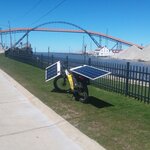1) Panel and controller.
You can but it will take all day or longer yet. With 600Wh bike battery discharged to 30% you need to put 420Wh back in, 6 hours of full sun @80W output after inverter losses - and you might not get 6 hours of full sun every day. In low overcast 90W panel will output 10W, in heavy rain 2-3W, do the math. Get a bigger panel if there is more room on the roof - 100W, 140W - the biggest you can fit.
12V panels only come 160-180W max. They are not actually 12V, it's a nominal voltage while the real voltage is 17-18V. Panels larger than 180W are nominal 24V and require more expensive MPPT controller.
Solar charger is called "controller" in this industry. 10A controller will suffice, PWM type, you don't need MPPT for nominal 12V panel. Don't buy $15 Ebay controllers, they are cr-ap, don't work well and die soon, damaging expensive AGM battery.
If you're not mounting solar permanently on the roof and prefer the pains of a portable panel, consider
100W Renogy Solar Suitcase . It folds compactly and comes with solar controller, $250 total.
2) Battery and inverter.
12V coach battery - i.e. in the car - should be deep cycle type, preferably AGM if it's inside. At least 100 AH, preferably 120 AH. They are not cheap, from $200. "Marine" AGM from Walmart or Costco will do, they are not truly deep cycle but will work for a while. If it's not rated in AH, it is not deep cycle. Connecting solar controller directly to inverter without coach battery is a bad idea, you may fry the controller.
Solar is "all or nothing" affair. When there is plenty of sun you'll charge either bike battery or coach battery or both, when bike battery is full the solar power goes to coach battery, when there is no sun you'll charge bike battery from coach battery. While you're riding, the panel is charging coach battery.
If your bike charger is 4A*50V=200W, inverter with 15% losses will draw 230W from AGM so you need 250-300W inverter. Preferably Pure Sine type, not Modified Sine. Look into Samlex brand, they are good and relatively cheap:
Samlex Pure Sine 350W. If your bike charger is 2A, you're good with 150W inverter. Install inverter as close to coach battery as possible, like a foot or two, and wire it to battery with at least gauge 10 cable. Starter cables gauge 6 work fine for that. Output 120V cable can be a usual household extension cable gauge 18 and length is not very important.
If your alternator is big enough, you can rewire alternator output to coach battery and charge coach battery much faster than with solar, when driving. Solar still won't hurt, it will be running quietly in the background, adding more amps, and will top-up the coach battery when you're parked.
So called "solar generators" are just a small panel with controller and small battery, total package usually overpriced for what it offers.
Hope this helps.

